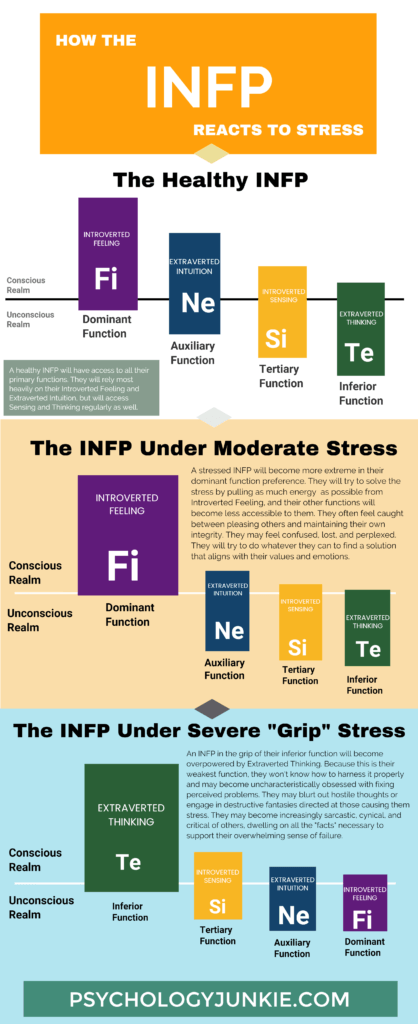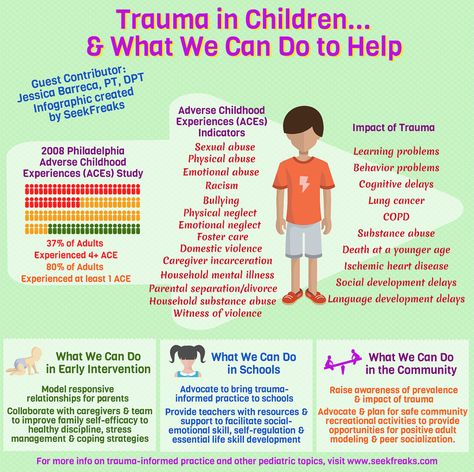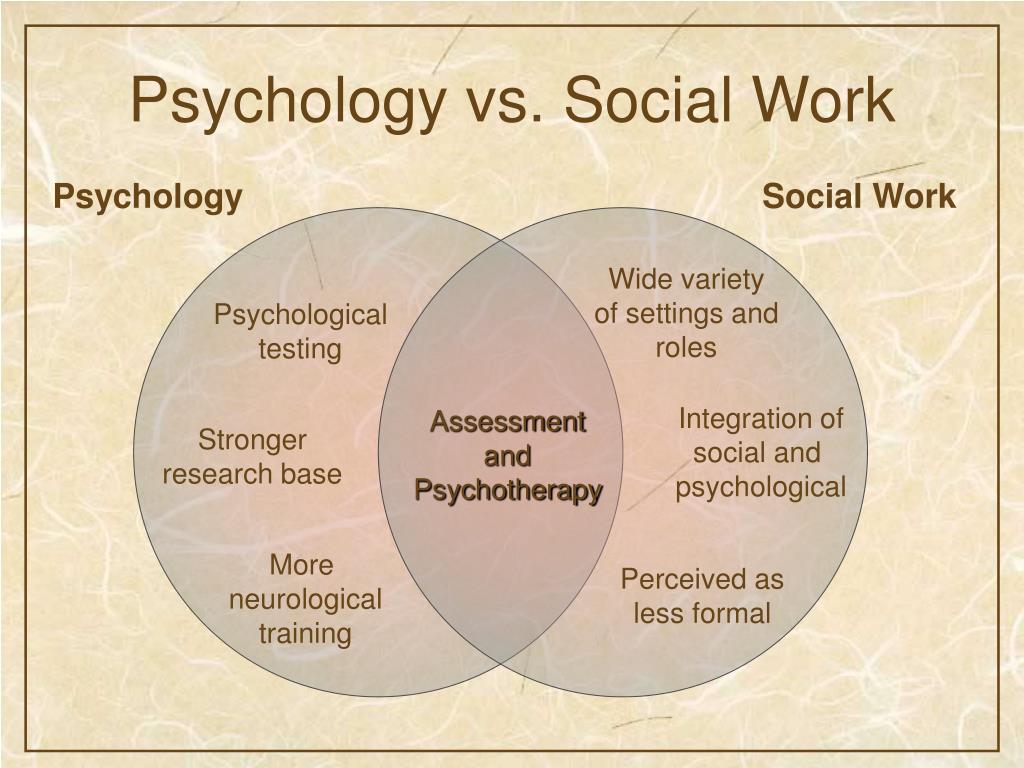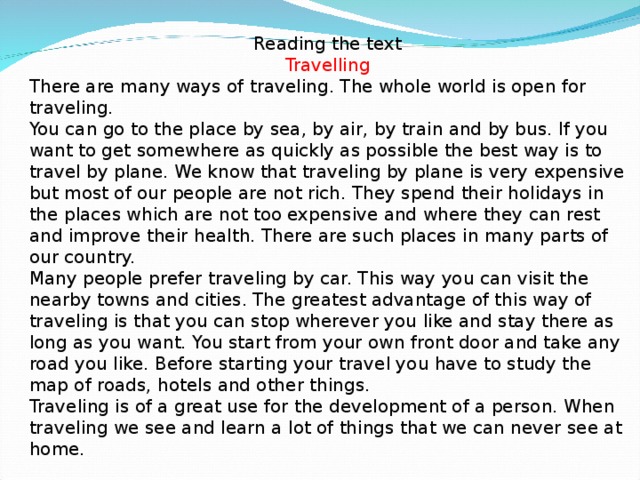The science of introverts
Why Introverts and Extroverts Are Different: The Science
I’m standing in the crowd in front of the stage at the small gritty music club. My two friends—both extroverts—are on either side of me, swaying along with the crooning Indie singer and smiling. I was having fun for a while, but now I’m ready to head home and find my bed. The loud music, the dense crowd of strangers, and the small talk I’ve made all night have left me feeling drained. It’s just too much, for too long, for an introvert like me.
I’d rather be in the peaceful solitude of my apartment. Just me, no noise, maybe a good book or the Internet to help me turn inward and recharge after this much socializing. Yet, my extroverted friends could probably stay at the concert, chatting long past the encore. They’ll actually feel energized when they leave and won’t need any recovery time. So, why do I react so differently than my extroverted friends to the same situation? The answer has to do with some key differences in the way introverts’ brains are wired.
One major difference between the brains of introverts and extroverts is the way we respond to the neurotransmitter dopamine. Dopamine is a chemical released in the brain that provides the motivation to seek external rewards like earning money, climbing the social ladder, attracting a mate, or getting selected for a high-profile project at work. When dopamine floods the brain, both introverts and extroverts become more talkative, alert to their surroundings, and motivated to take risks and explore the environment.
It’s not that introverts have less dopamine present in their brains than extroverts do. In fact, both introverts and extroverts have the same amount of dopamine available. The difference is in the activity of the dopamine reward network. It is more active in the brains of extroverts than in the brains of introverts as Scott Barry Kaufman, the Scientific Director of The Imagination Institute, explains in this short video:
At the expectation of, say, getting the phone number of an attractive person or earning a promotion at work, extroverts become more energized than introverts. They buzz with an enthusiastic rush of good feelings, while introverts feel overstimulated.
For my extroverted friends, the noise and the crowd at the concert were simply all part of the fun. In fact, this intensity of stimulation acted as a cue to them that they were achieving their goal (the reward of socializing and a fun night out). Yet, for me, as the night wore on, the hubbub became annoying and tiring—even punishing—as I became overstimulated.
For introverts, acetylcholine is where it’s atIntroverts prefer to use a different neurotransmitter called acetylcholine, writes Christine Fonseca in her book Quiet Kids: Help Your Introverted Child Succeed in an Extroverted World. Like dopamine, acetylcholine is also linked to pleasure; the difference is, acetylcholine makes us feel good when we turn inward. It powers our abilities to think deeply, reflect, and focus intensely on just one thing for a long period of time. It also helps explain why introverts like calm environments—it’s easier to turn inward when we’re not attending to external stimulation. When I lounge at home in quiet solitude, lost in a book or watching Netflix, I’m basking in the pleasant effects of acetylcholine.
Like dopamine, acetylcholine is also linked to pleasure; the difference is, acetylcholine makes us feel good when we turn inward. It powers our abilities to think deeply, reflect, and focus intensely on just one thing for a long period of time. It also helps explain why introverts like calm environments—it’s easier to turn inward when we’re not attending to external stimulation. When I lounge at home in quiet solitude, lost in a book or watching Netflix, I’m basking in the pleasant effects of acetylcholine.
Another piece of the introvert-extrovert puzzle has to do with the nervous system, writes Dr. Marti Olsen Laney in her book The Introvert Advantage: How to Thrive in an Extrovert World. Acetylcholine is linked to the parasympathetic side of the nervous system, which is nicknamed the “throttle down” or “rest-and-digest” side. When we engage the parasympathetic side, our body conserves energy, and we withdraw from the outer environment. Our muscles relax; energy is stored; food is metabolized; pupils constrict to limit incoming light; and our heart rate and blood pressure lower. Basically, our body gets ready for hibernation and contemplation—two of the things introverts like the most.
Our muscles relax; energy is stored; food is metabolized; pupils constrict to limit incoming light; and our heart rate and blood pressure lower. Basically, our body gets ready for hibernation and contemplation—two of the things introverts like the most.
Both introverts and extroverts use both sides of their nervous systems at different times, just like they use both neurotransmitters. But—no big shocker here—extroverts tend to favor the opposite side of the nervous system: the sympathetic side, known as the “full-throttle” or “fight, flight, or freeze” system. This side mobilizes us to discover new things and makes us active, daring, and inquisitive. The brain becomes alert and hyper-focused on its surroundings. Blood sugar and free fatty acids are elevated to give us more energy, and digestion is slowed. Thinking is reduced, and we become prepared to make snap decisions. While extroverts thrive on the dopamine-charged good feelings created when they engage the sympathetic side, for us introverts, it’s too much.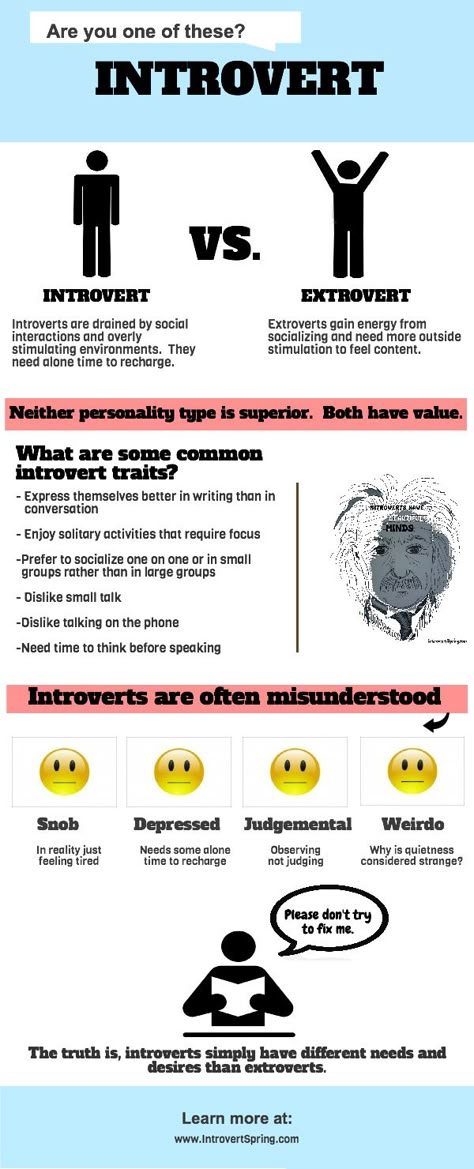
If you don’t understand introversion, you might get the mistaken idea that introverts are antisocial, reclusive, or rude. At the concert, I bolted for the door the first chance I got, leaving my extroverted friends behind. I imagine they only reluctantly left after the last song was played, the lights came on, and a security guard brusquely ushered them toward the door. Yet, given how my introverted brain works, it makes sense that after a few hours of stimulation and socializing, I needed to get out of there. It’s not that I dislike people; it’s just that socializing is more effortful and tiring for me than it is for extroverts. Curled up back at home, in a calm, familiar environment, I unwound and relaxed. Sure, I would go to another concert and hang out with the extroverts again, but only after some soothing alone time—and not a moment sooner.
Introverts' and Extroverts' Brains Really Are Different, According to Science
You’re not imagining it. Your extroverted friend who seems so different from you? It’s because her brain is different.
Your extroverted friend who seems so different from you? It’s because her brain is different.
Here’s a quick-and-dirty guide to some key differences between introverts’ and extroverts’ brains, according to science — and let me tell you, it explains a lot.
Introverts Are Sensitive to Dopamine
Why do extroverts like action, but introverts like calm?
It may have to do with two powerful chemicals found in the brain — dopamine and acetylcholine, “jolt juices” that hugely impact our behavior.
Dopamine gives us immediate, intense zaps of happiness when we act quickly, take risks, and seek novelty. Acetylcholine, on the other hand, also rewards us, but its effects are more subtle — it makes us relaxed, alert, and content.
One explanation for introversion vs. extroversion, according to Dr. Marti Olsen Laney in her 2002 book, The Introvert Advantage, is extroverts are less sensitive to dopamine, so they need more of it to feel happy. The more they talk, move, and socialize, the more they feel dopamine’s pleasant effects.
But when it comes to us “quiet ones,” too much dopamine can overstimulate us, writes Laney, like a kid with a tummy ache hopped up on too much sugar. On the other hand, when we read, concentrate, or use our minds in some way, we feel good because our brains release acetylcholine — a happiness bump so gentle that extroverts hardly register it.
This explains, on some level, why extroverts may seek new and exciting situations — as well as social opportunities — while introverts would rather stay home with a good book or hang out in a meaningful way with just one other person.
From “The introvert brain explained”Introverts Prefer a Different Side of Their Nervous System
Another difference between introverts and extroverts has to do with our nervous systems. Everyone’s nervous system has two “sides” — the sympathetic side, which triggers the “fight, fright, or flight” response, and the parasympathetic side, which is responsible for “rest and digest” mode.
In other words, the sympathetic side is like hitting the gas pedal, while the parasympathetic side is like slamming on the brakes.
When your sympathetic system is activated, your body gears up for action. Adrenaline is released, glucose energizes muscles, and oxygen increases. Areas of your brain that control careful, measured thinking are turned off, although dopamine increases alertness in the back of your brain.
On the other hand, when you engage the parasympathetic side, your muscles relax, energy is stored like a squirrel preparing for winter, and food is metabolized. Acetylcholine increases alertness and blood flow to the front of your brain.
To be clear, extroverts and introverts use both sides of their nervous systems at different times. But which side do we introverts generally prefer? You’ve probably already guessed: According to Dr. Laney, we prefer the parasympathetic side, which slows and calms us.
Introverts Use the Long Acetylcholine Pathway
Ever wonder why, as an introvert, you are prone to overthinking? It may have to do with how we process stimuli differently than extroverts.
When information from the outside world — like someone’s voice or images on a computer screen — enters an extrovert’s brain, it travels a shorter pathway, Laney theorizes. It passes through “quick response” areas of the brain where taste, touch, sight, and sound are processed.
From “The introvert brain explained”But for introverts, the pathway may be longer, traveling through many areas of the brain, including:
- The right front insular, which is an area associated with empathy, self-reflection, and emotional meaning. This is also the area of the brain that notices errors.
- Broca’s area, which plans speech and activates self-talk.
- The right and left front lobes, which select, plan, and choose ideas or actions. These areas also develop expectations and evaluate outcomes.
- The left hippocampus, which stamps things as “personal” and stores long-term memories.
If Laney’s theory is correct, this means introverts process information more thoroughly than extroverts do. No wonder it can take us longer to put our thoughts into words, react, or make decisions!
No wonder it can take us longer to put our thoughts into words, react, or make decisions!
Introverts Have More Gray Matter
Finally, a study published in the Journal of Neuroscience found that introverts had larger, thicker gray matter in their prefrontal cortex — the area of the brain associated with abstract thought and decision-making. Extroverts had thinner gray matter in that same area. This suggests that introverts may devote more neural resources to abstract thought, while extroverts tend to live in the moment more.
Join the introvert revolution. Subscribe to our newsletter and you’ll get one email, every Friday, of our best articles. Subscribe here.
What This Research Means
It means that as an introvert, you were probably born this way. Although you will grow and change over time — as we all do — you’ll always have a general preference for solitude and calm. (Read more about the science behind why you probably won’t stop being an introvert here.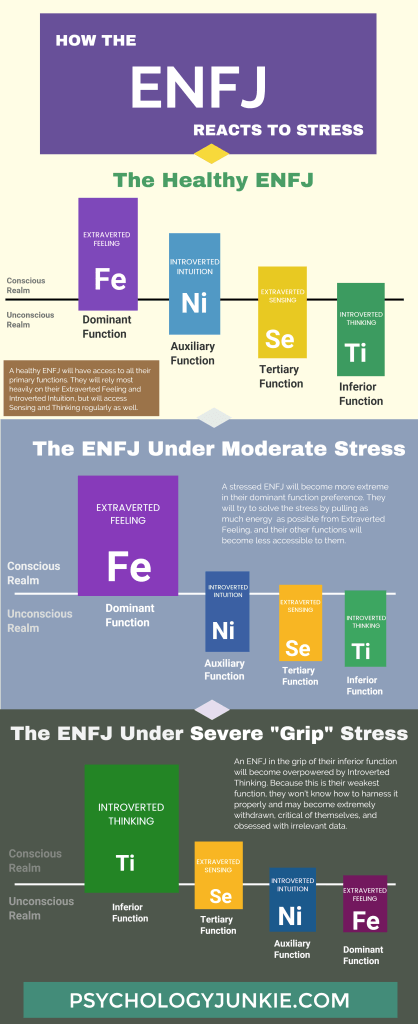 )
)
It doesn’t mean you’ll never enjoy a party or seek new and exciting experiences. Nor does it mean that extroverts will never enjoy the peace that comes with solitude — we still get to choose what we do. And, interestingly, there’s some evidence that our personalities change over time (for the better), including that fact that we all get more introverted as we get older.
Keep in mind that “introversion and extroversion are not black and white. No one is completely one way or another — we all must function at times on either side of the continuum,” writes Dr. Laney in The Hidden Gifts of the Introverted Child.
So those loud, rowdy extroverts? Cut them a little slack. It’s their brain!
Do you ever struggle to know what to say?
As an introvert, you actually have the ability to be an amazing conversationalist — even if you’re quiet and hate small talk. To learn how, we recommend this online course from our partner Michaela Chung. Click here to check out the Introvert Conversation Genius course.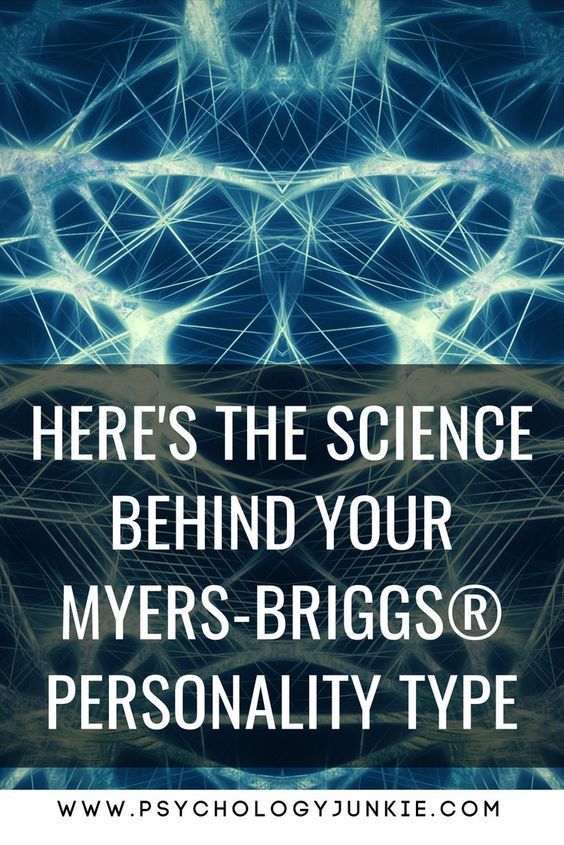
You might like:
- Why Do Introverts Love Being Alone? Here’s the Science
- What I Wish People Knew About Me as an ‘Extroverted’ Introvert, Illustrated
- Here’s What Makes Each Introverted Myers-Briggs Personality Type Angry
This article contains affiliate links. We only recommend products we truly believe in.
"Turned inward": what science knows about introverts
Consciousness
8/25/2021
Why are introverts so unsociable and how can they turn their weaknesses into strengths
Marina Khrapova / Unsplash
Psychologist divided people into introverts and extroverts Carl Gustav Jung in 1921 in Psychological Types. By his definition, an introvert is a person who is turned to himself and perceives reality indirectly, through the prism of his inner world. In extroverts, behavior is motivated mainly by external stimuli. Jung's theory was developed in 1950s psychologist Hans Eysenck, who believed that introverts differ from extroverts in increased sensitivity to external stimuli.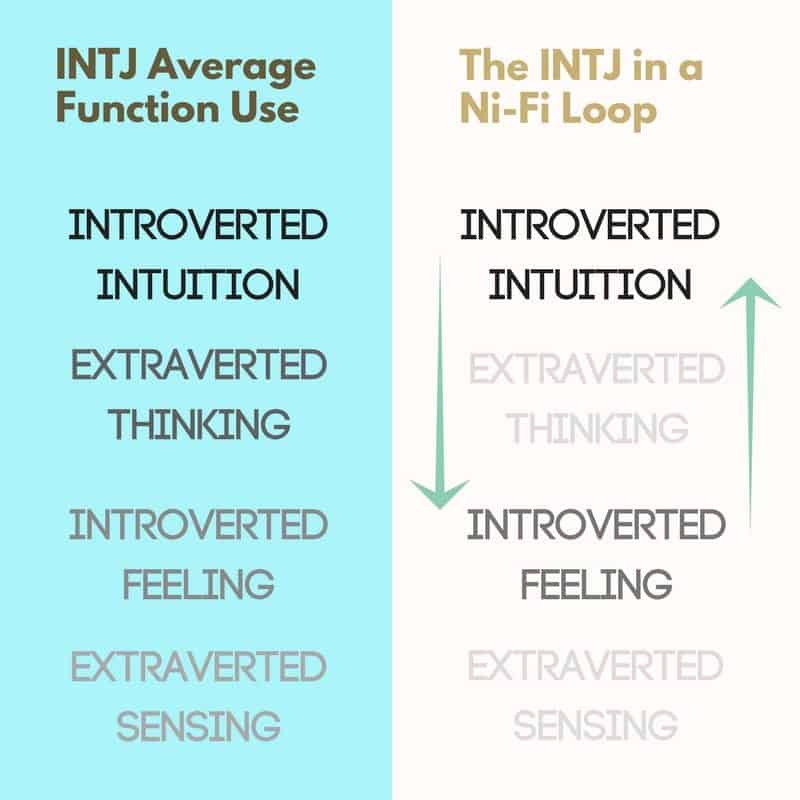 Modern science has confirmed his idea, but has made several important additions. Reminder has collected the most interesting things that are known about introverts now.
Modern science has confirmed his idea, but has made several important additions. Reminder has collected the most interesting things that are known about introverts now.
4 types of introversion
Scientific definitions for a long time could not fully convey the image that people have when they hear the word "introvert" and how introverts themselves feel. So far, the description given by psychologist Jonathan Cheek is considered the most complete. Summarizing scientific theories and research, he identified four types (or manifestations) of introversion - social, mental, anxious and reserved:
-
Social introvert. This is how others traditionally imagine an introvert: a person who prefers to socialize in small groups or spend time alone. At the same time, social introversion cannot be equated with shyness: in this case, the restriction of social contacts is a conscious choice, and not a manifestation of social anxiety.
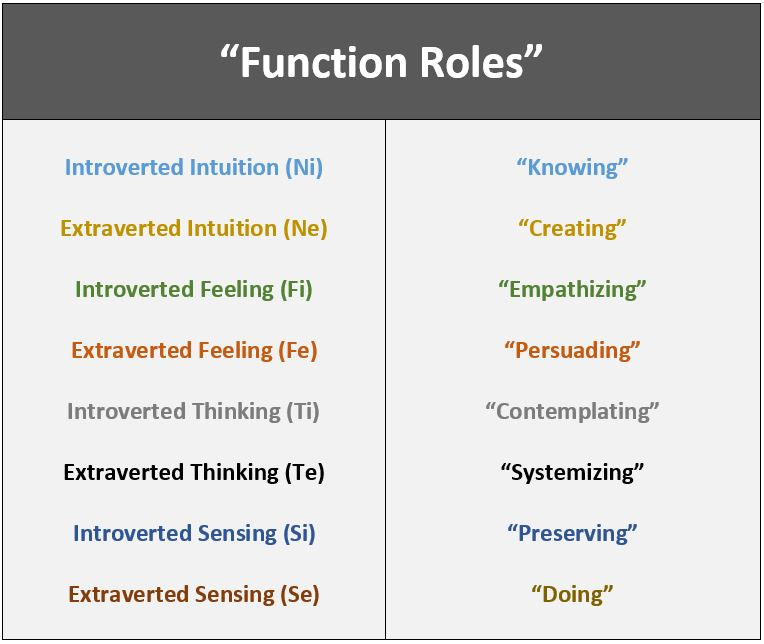
-
Thinking introvert. A person focused on his inner world, prone to reflection and analysis of his actions, thoughts and emotions. He always passes external stimuli through a reflection filter. Often immersed in fantasy and always full of ideas. nine0003
-
Anxious introvert. Unlike social introverts, this type of personality avoids contact because they feel insecure about their social skills. At the same time, their level of anxiety does not decrease when they are left alone. They are constantly haunted by thoughts of problems—past, present, and future.
-
Reserved introvert. A person who tries not to give in to emotions and avoids everything new. He thinks about his words and actions in advance, refraining from spontaneity. nine0003
These are just basic features. The degree of their manifestation in introverts varies individually. To determine what type of introversion you are prone to, you can use the Chick test (in Russian it can be found here).
The degree of their manifestation in introverts varies individually. To determine what type of introversion you are prone to, you can use the Chick test (in Russian it can be found here).
Neurobiology of introversion
There are less impulsive people among introverts. Apparently, this is due to neurobiological features. In one study, researchers found that compared to extroverts, introverts have more gray matter in areas of the brain involved in thinking and planning. This has its pros and cons: the risk of irrational actions is lower, but the likelihood of developing anxiety and depression is higher. nine0003
Another study confirmed Eysenck's theory that introverts are more sensitive to external stimuli: they need fewer external stimuli to get fed up. Perhaps it's all about dopamine, a neurotransmitter by which the brain rewards us with a feeling of pleasure for certain actions and thus encourages us to repeat them. The experiment showed that in response to a monetary gain in three of the six areas of the brain responsible for reward, introverts produce several times less dopamine than extroverts.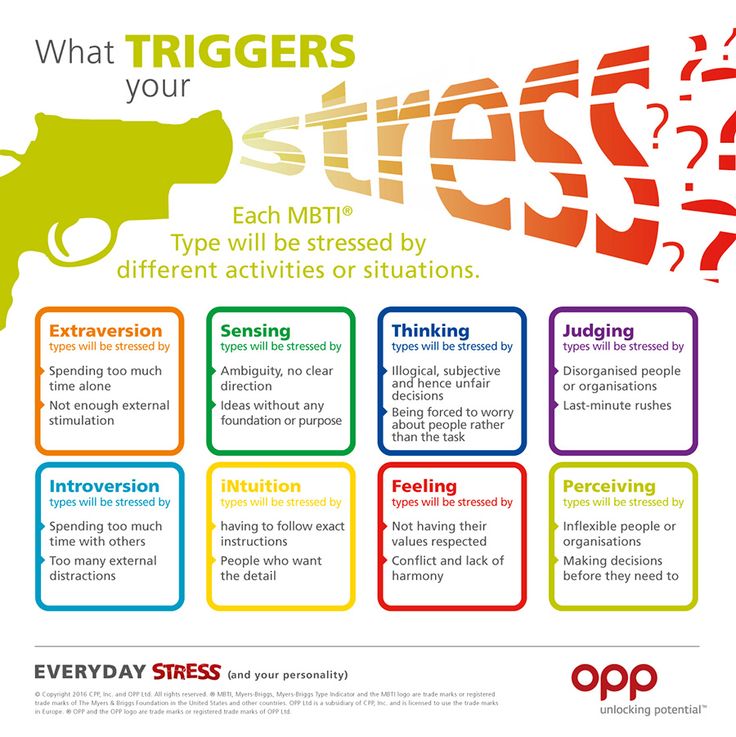 nine0003 Difference in dopamine production in the brain of an introvert (left) and an extrovert (right) in the left and right medial orbitofrontal cortex and in the right side of the nucleus accumbens
nine0003 Difference in dopamine production in the brain of an introvert (left) and an extrovert (right) in the left and right medial orbitofrontal cortex and in the right side of the nucleus accumbens
Why are introverts so uncommunicative? In search of an answer, American scientists conducted an experiment in which subjects with different levels of extraversion were shown interspersed with faces and flowers. Their brain activity was monitored using an electroencephalograph. It turned out that human faces attract the attention of an introvert no more than images of flowers. But for an extrovert, the face is a very strong external stimulus. This can be seen from the jump in activity in the parietal region:
This does not mean that introverts are absolutely indifferent to social contacts. But they clearly experience less pleasure from communication and do not need it as much as extroverts, who even tend to humanize robots. Unlike extroverts, who try to expand their circle of contacts in order to provide themselves with as much social stimulation as possible, introverts are satisfied with the incentives that they receive alone or in small familiar companies. nine0043
But they clearly experience less pleasure from communication and do not need it as much as extroverts, who even tend to humanize robots. Unlike extroverts, who try to expand their circle of contacts in order to provide themselves with as much social stimulation as possible, introverts are satisfied with the incentives that they receive alone or in small familiar companies. nine0043
Introverts and happiness
Research shows that introverts have much lower levels of life satisfaction than extroverts (1, 2). Perhaps the reason is a tendency to rumination (wandering thoughts, not always positive), introspection and overanalysis. All this can lead to anxiety and depression.
Interestingly, introverts can increase their level of happiness if they periodically behave like extroverts. This was shown by a large cross-cultural study involving residents of the United States, China, Japan, Venezuela and the Philippines. The subjects filled out a two-part questionnaire for 20 days at intervals of several hours.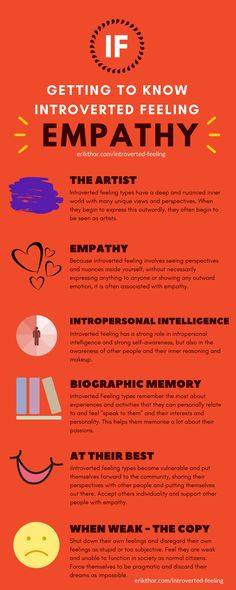 In the first, they described themselves and their behavior in accordance with the five-factor personality model (extroversion, agreeableness, conscientiousness, openness to experience, and emotional stability). And in the second, the emotional state of the subjects was assessed. It turned out that when introverts communicated more, made new acquaintances and behaved more openly, they were more satisfied with their lives. And this is not surprising, because active and diverse social connections, which are usually more developed among extroverts, are a powerful factor in life satisfaction. nine0003
In the first, they described themselves and their behavior in accordance with the five-factor personality model (extroversion, agreeableness, conscientiousness, openness to experience, and emotional stability). And in the second, the emotional state of the subjects was assessed. It turned out that when introverts communicated more, made new acquaintances and behaved more openly, they were more satisfied with their lives. And this is not surprising, because active and diverse social connections, which are usually more developed among extroverts, are a powerful factor in life satisfaction. nine0003
To think more creatively, introverts need to relax
Australian scientists came to these conclusions after an experiment in which introverts and extroverts learned to activate creativity using different techniques. The subjects were randomly divided into two groups. In one, they showed a training video with creative thinking techniques (for example, with exercises on using random objects to generate ideas).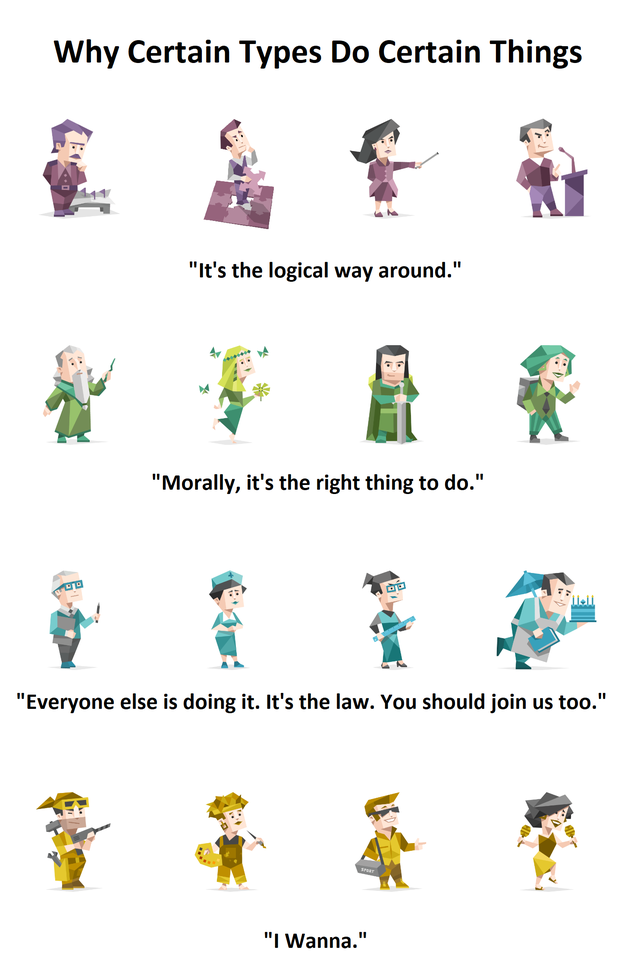 Another showed a video teaching breathing, relaxation and meditation techniques. It turned out that introverts, when performing tests for creative thinking, were more helped by relaxation and meditation, and extroverts - learning practical techniques. nine0003 How effective are different techniques for activating creative thinking for extroverts (the first three columns) and introverts (the second three columns): "control" - the result of the control test before the exercises, "relaxation" - the results of the test after exercises for relaxation and awareness, "ideation" - test results after exercises for creative thinking
Another showed a video teaching breathing, relaxation and meditation techniques. It turned out that introverts, when performing tests for creative thinking, were more helped by relaxation and meditation, and extroverts - learning practical techniques. nine0003 How effective are different techniques for activating creative thinking for extroverts (the first three columns) and introverts (the second three columns): "control" - the result of the control test before the exercises, "relaxation" - the results of the test after exercises for relaxation and awareness, "ideation" - test results after exercises for creative thinking
According to scientists, the reason is that it is important for introverts to temporarily stop the flow of thoughts and free the brain to generate new ideas. And for this, meditation and other practices of relaxation and awareness are ideal. nine0003
Lack of communication skills is a weakness and strength of introverts
By the type of thinking, introverts are more focused on themselves. Hence stereotypical ideas that introverts are not suitable for activities that require developed communication skills. In fact, everything is not so clear. What introverts lack in communication skills they make up for in their increased attentiveness and analytical skills.
Hence stereotypical ideas that introverts are not suitable for activities that require developed communication skills. In fact, everything is not so clear. What introverts lack in communication skills they make up for in their increased attentiveness and analytical skills.
A good example is the study of foreign languages. Introverts and extroverts use different strategies to develop this skill. Extroverts try to find and use every opportunity to communicate with native speakers, while introverts focus on working with information. At the same time, as studies show, there is no correlation between the level of foreign language proficiency and openness to communication. nine0003
Another stereotype: lack of communication skills entails inability to understand people. In fact, the opposite is true. As scientists from Yale University found out, introverts understand people better than extroverts. This is most likely explained by the fact that, unlike extroverts, who spend all their energy on establishing communication with the maximum number of people, introverts are focused on observation and analysis.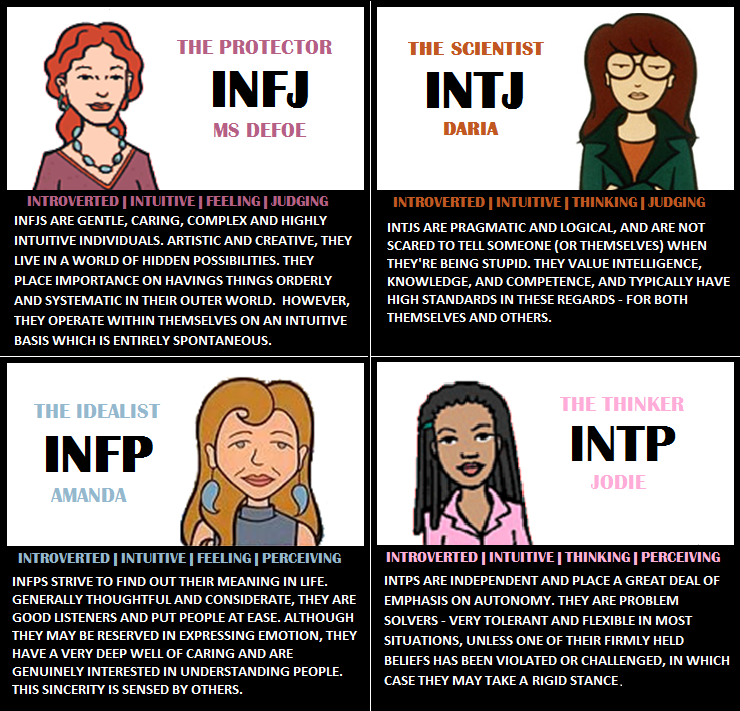 In this, introverts are also helped by a tendency to self-reflection: thanks to the knowledge of their own psychology, they often guess other people's motives. nine0003
In this, introverts are also helped by a tendency to self-reflection: thanks to the knowledge of their own psychology, they often guess other people's motives. nine0003
5 surprising facts about introverts and extroverts
How do you feel about spending more time at home? Do you dream of noisy companies, office open spaces and precious minutes of attention at parties? Or do you enjoy solitary evenings, free weekends and the opportunity to work remotely? In both cases, now is a good time to read Introverts by Susan Cain. How to use the features of your character, ”yes, you understood correctly: even if you do not consider yourself one of those. nine0003
Introverts. How to use your personality traits
Kane S.
The habitual practice of building a career for a modern person requires sociability, pressure and the ability to present oneself. Society encourages the manifestation of these qualities, thus contributing to a kind of "natural selection".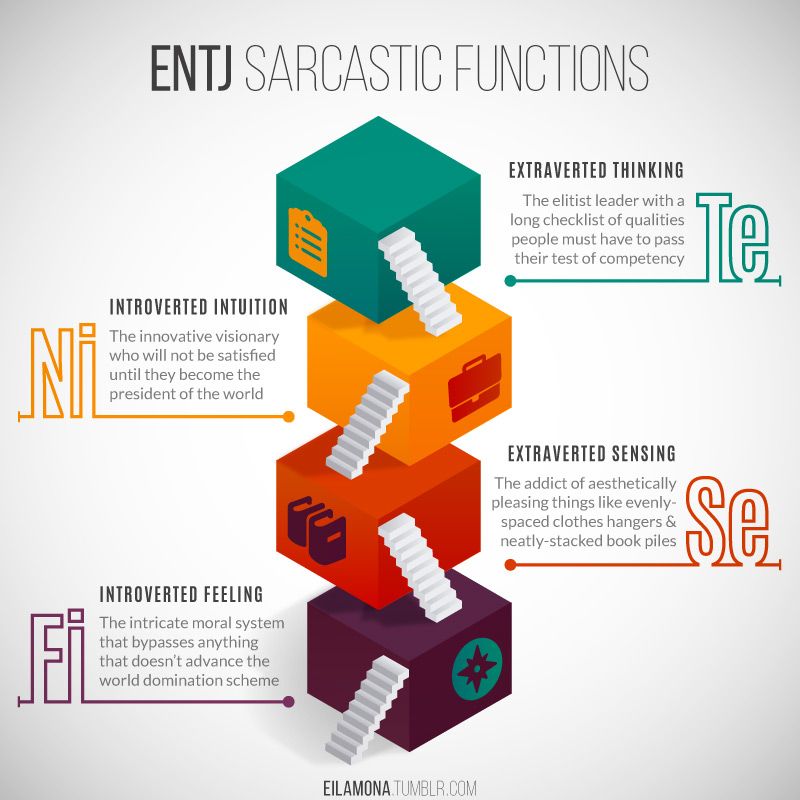
Public opinion puts enormous pressure on us. What to do with a person who does not meet the established standards? Susan Cain convinces us that introverts are just as capable as extroverts of coping with complex tasks. And sometimes, due to the peculiarities of their temperament, they manage to do it much better. nine0003
Here are 5 unexpected facts from this book that may surprise you:
1. Introverts and extroverts are not only people, but also representatives of the animal world.
2. There is approximately the same percentage of introverts and extroverts among people. However, introversion is more often preferred to be hidden, because today's society is set up for extroverts.
3. However, most people are able to display introvert and extrovert mode, depending on the current situation. That is, they combine those and other features. It’s just that some are more pronounced and located in the so-called human comfort zone. nine0003
4.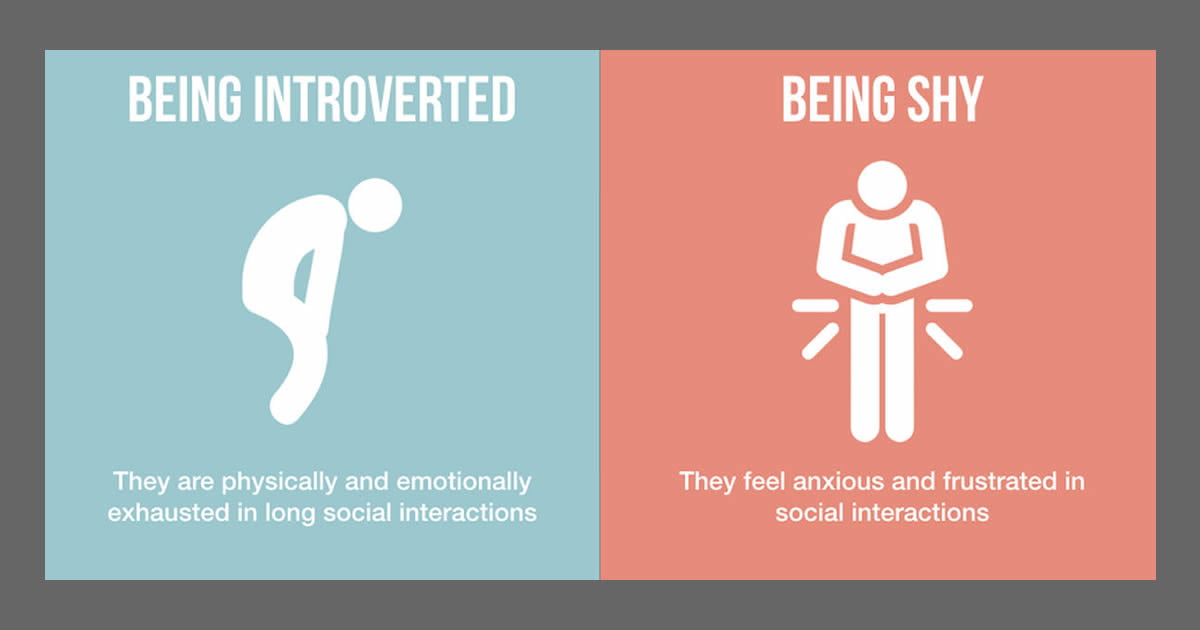 Introversion and extraversion are formed in the first months of life or even during pregnancy. By the age of four months, a baby can most likely be assigned to one of two groups.
Introversion and extraversion are formed in the first months of life or even during pregnancy. By the age of four months, a baby can most likely be assigned to one of two groups.
5. Introverts have a more active neocortex - the area of the brain that is responsible for decision making, rational thinking and planning. Extroverts are dominated by the limbic lobe, which is responsible for instincts and emotions.
Two types of temperament were first identified a hundred years ago by the famous Swiss psychiatrist Carl Jung. He noted that extroverts pay great attention to the outside world and experience discomfort with a long absence of social contacts. Introverts are more self-absorbed and need regular solitude. nine0003
However, the modern “fashion” for extroverts is an exclusively social phenomenon and, with a high probability, temporary. Perhaps the balance of power in favor of showing their maximum in solitude introverts is changing in the world right now. In any case, this does not mean at all that one is better than the other. The main thing to know about introverts and extroverts is that they are able to open up to their full potential in the right conditions. And the creation of such conditions is quite within the power of them.
The main thing to know about introverts and extroverts is that they are able to open up to their full potential in the right conditions. And the creation of such conditions is quite within the power of them.
Perhaps you also know cases when someone you know was known as an introvert for a long time, and then revealed himself as a real extrovert, becoming the soul of the company and achieving success at work. This does not mean that the person has changed. This means that he was able to choose the right occupation and built relationships with people suitable for him. In a word, he created a favorable environment that allowed him to feel supported and safe. nine0003
This is called "reciprocal correspondence between the individual and the environment." Psychologist Brian Little found that people succeed if they "deal with jobs, roles, and conditions appropriate to their personality type." Dependence also works in the opposite direction - conditions that are not suitable for our type of personality lead to burnout and the cessation of self-development.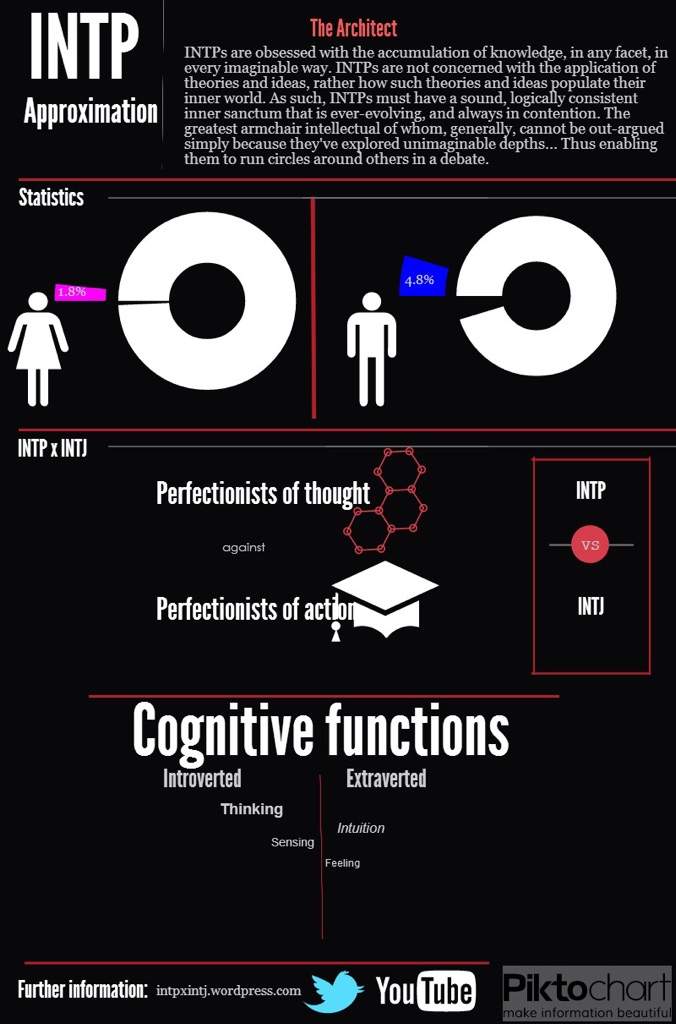
A lot of interesting and useful information about all this and much more - in the book by Susan Cain "Introverts. How to use the features of your character. From it you will learn how to find your comfort zone and use it to the maximum. How to raise an introverted child and help him create a supportive environment. That among leaders of almost any scale there are both extroverts and introverts, it’s just that both differ in their leadership styles. And that extroverts and introverts can turn any situation to their advantage - just in different ways. nine0003
Despite the title clearly naming "target audience", this book will be useful for extroverts too. For example, from the knowledge gathered in it, we have formulated a few simple tips that will help to more easily survive isolation for those who cannot do without the attention of others for a long time. And we advise you to read it for your own conclusions. And a better understanding of yourself - as well as the world around you.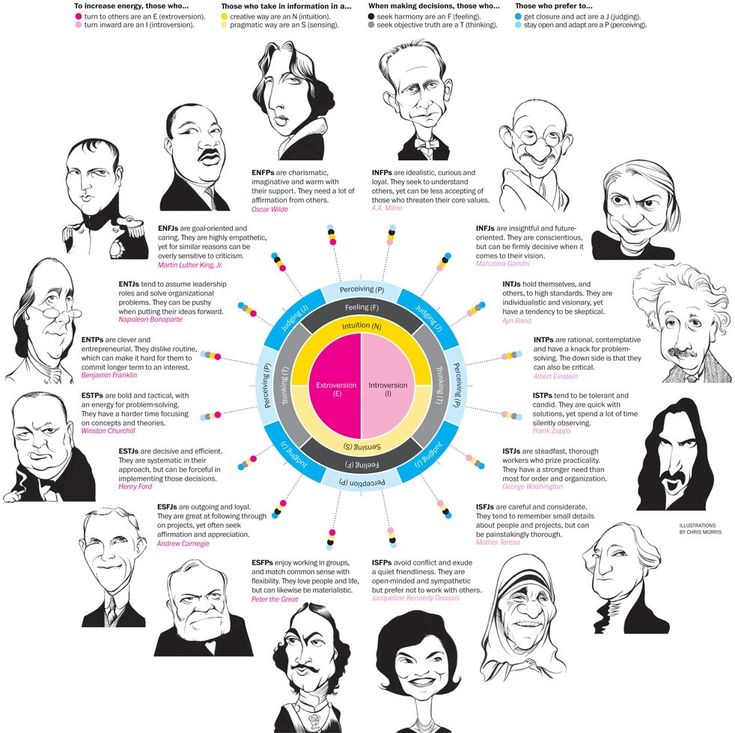
An extrovert in isolation: how to make life better
☆ Organize your workplace in the center of the room or somewhere in a conspicuous place. So that family members pay attention to you more often and do not forget to communicate with you. nine0003
☆ If possible, use video calls and conference calls instead of business emails. This will help you get the attention you need and connect with people in a way that's right for you.
☆ Record videos and share your thoughts about anything on social networks. Likes and comments are the most accessible form of social approval right now and will help extroverts feel like they're being seen.
☆ Throw a video call party. Your need to feel like the soul of the company takes on new technologies. nine0003
☆ Create chats. Friendly chat and chat with colleagues, neighbor and interest chat - a lot of parallel conversations will also benefit your thirst for communication. In this form, they even have an additional plus: at your discretion, you can take a break by turning off notifications.